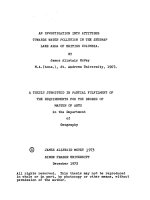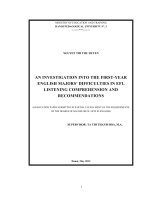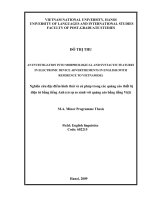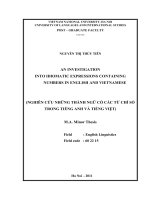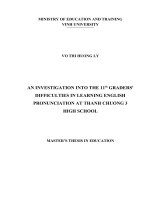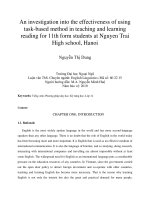An investigation into ways of using english in american universities facebook pages (tt)
Bạn đang xem bản rút gọn của tài liệu. Xem và tải ngay bản đầy đủ của tài liệu tại đây (350.59 KB, 27 trang )
THE UNIVERSITY OF DA NANG
UNIVERSITY OF FOREIGN LANGUAGE STUDIES
NGUYỄN MẬU VŨ
AN INVESTIGATION INTO WAYS OF USING
ENGLISH IN AMERICAN UNIVERSITIES’
FACEBOOK PAGES
Major: ENGLISH LINGUISTICS
Code: 822.02.01
MASTER THESIS
IN FOREIGN LANGUAGES - LITERATURE AND CULTURE
(A SUMMARY)
Da Nang, 2018
The thesis has been completed at University of Foreign Language
Studies, The University of Da Nang
Supervisor: A/Prof. Dr. Nguyễn Văn Long
Examiner 1: Assoc. Prof. Dr. Trần Hữu Phúc
Examiner 2: Dr. Bảo Khâm
The thesis was orally defended at the Examining Committee
Time: 27th October 2018
Venue: University of Foreign Language Studies
- The University of Da Nang
The thesis is available for the purpose of reference at:
- Library of University of Foreign Language Studies, The
University of Da Nang
- The Information Resources Centre, The University of Da Nang
1
Chapter One
INTRODUCTION
1.1. RATIONALE
Social networks have a strong influence on the society more and
more in every field. They play an important role in helping people
keep in touch with each other, particularly in online communications
and interactions. And language is still the most essential component.
The phenomenon that language has been used in various novel
ways is appeared increasingly on social networks, gradually
infiltrating into social communication, even appeared in English
course book for students. Many global linguists consider this
phenomenon as a plentiful resource for investigating extensively.
Some of them are Bodomo and Crystal whom the author spent a lot
of time on in terms of new forms of language in computer-mediated
communication.
Like Bodomo (2010), the author supports the view that there is a
causal relationship between the emergence of new tools of
communication and the creation of new forms of language.
Therefore, the author would like to carry out the research entitled
“An investigation into ways of using English in American
Universities’ Facebook Pages”.
1.2. AIMS and OBJECTIVES
1.2.1. Aims
This study aims to investigate various ways of English use in
American universities’ Facebook pages in the situation of strong
development of social networking sites. In addition, the study is
responsible for seeking the main reasons which lead to innovative
linguistic and technological events.
2
1.2.2. Objectives
· To classify new forms of language use according to Bodomo’s
theoretical view, and then update or complement new things in
terms of non-standard orthography.
· To show and identify new ways of English use from posts and
comments according to Crystal’s theory in terms of vocabulary,
grammar, pragmatics, and style.
· To analyze factors leading to the ways of using English on these
pages.
1.3. RESEARCH QUESTIONS
1. Does the language used in American universities’ Facebook
pages retain the developed linguistic features comparing with
Bodomo’s model and studies (2010)?
2. What are the innovative ways of using English in American
universities’ Facebook pages?
3. What factors lead to the innovation of using English in these
pages?
1.4. SCOPE OF THE STUDY
With the aims and objectives mentioned, this study focuses on
investigating ways of English use from posts and comments in the
year 2016 of five official American universities’ Facebook pages,
including Princeton University, Harvard University, Yale University,
Columbia University, Massachusetts Institute of Technology (MIT).
However, the thesis is just based on the viewpoints and studies of
Bodomo (2010) and Crystal (2006, 2011) regarding online linguistic
characteristics.
1.5. DEFINITIONS OF TERMS
1.5.1. Non-standard orthography
3
1.5.2. Facebooker
1.6. SIGNIFICANCE OF THE STUDY
This research is a synthetic, additional and up-to-date
exploration of English use on Facebook sites. Therefore, this study is
hoped to be a practical piece of work to help English learners to have
a comprehensive understanding of English use in the case of social
networks. More importantly, it can be used as a reliable source of
reference for those who are interested in language change at the time
of information and technology explosion.
1.7. ORGANIZATION OF THE STUDY
Chapter Two
LITERATURE REVIEW AND
THEORETICAL BACKGROUND
2.1. LITERATURE REVIEW
Recently, Nguyễn Văn Long (2011) has paid much attention to
sociolinguistics in the digital media age. Especially, as being an
expert
on
application
of
Information
and
Communication
Technology (ICT) into language education, he clarifies the
importance of Computer-mediated Communication (CMC) as a tool
of foreign language learning (Nguyễn Văn Long, 2015a) because
CMC has various pedagogical features (Nguyễn Văn Long, 2013)
which are believed to play significant roles in modern teaching
methodology. Besides, through his meta-analysis (Nguyễn Văn Long,
2015b) of the relationship between the concepts including discourse,
technology, multi-dimensional communication and ideology in the
digitized era, we should agree with him that technology changes so
fast that “new elements” quickly become “ex-elements” in digital
4
media. Nowadays anyone who wants to get information about
language use on the internet cannot ignore the publication “Internet
Linguistics” by David Crystal in 2011. Concerning the CMC field,
Bodomo (2010) proposes a model which is called Technologyconditioned approach to Language Change and Use (TeLCU). He
suggests that there is a causal relationship between the emergence of
new tools and media of communication in our society and the use of
language. It is the theoretical basis for himself and for many authors
in investigations of the development of language variation through
CMC. Also, research on social networking sites, such as Facebook
and others (Boyd & Ellison, 2007) starts to profile user behaviors and
characteristics (Ellison, Steinfield, & Lampe, 2007; Golder,
Wilkinson & Huberman, 2007; Lampe, Ellison, and Steinfield,
2007). Especially, Ellison et al. (2007) provide an overview of
Facebook. Until now, application of social networks for research on
human activities has been far-reaching around the world. It is mainly
towards two major directions. Linguists concerned with linguistic
features or practices collected from social networking exchange,
while scholars considered WBSNs (Web-based Social Networks) as a
motivative tool for foreign language teaching and learning. After
reviewing Bodomo’s research presented in the book ComputerMediated Communication for Linguistics and Literacy: Technology
and Natural Language Education (2010), we find that the question of
whether the new communication technologies are changing language
structure and use is perhaps the central preoccupation of linguists
working in the field of CMC. However, someone can argue that in
the period of Industry 4.0, many things will be changed for suitable
situations because of technological involvement, whether human
5
communication and exchange rely much more on the online manners
or not. This is the important reason why research on the relationship
between CMC and language change is necessary for new language
trends in the future.
2.2. THEORETICAL BACKGROUND
2.2.1. Information and Communication Technology (ICT)
2.2.2. Computer-Mediated Communication (CMC)
2.2.3. Sociolinguistics
2.2.4. Social Networks
In the article “Social networks and language change: what does
research tell us?” (2017), the writer clarifies Early and Modern
Social Networks, as well as provides some evidence about the
relationship between social networks and language change. And in
this study, we mention social networks as modern social networks,
more exactly web-based social networks (WBSNs), which are online
communities that allow users to publish resources and to establish a
relationship for certain purposes, such as business, entertainment,
dating...
2.2.5. Facebook
Facebook, created by Mark Zuckerberg in 2004 is the most
widely used social networking site to date, with 1.79 billion monthly
active users (Statista, 2017).
It has one, of many others, asynchronous messaging feature,
namely status updates, which conform to the micro-blogging concept
(Köbler et al., 2010). This feature enables users to post short
messages that communicate their feelings, thoughts, whereabouts,
inquiries or any information that they want to share with their friends.
Users can also post photos, videos or links in the status box. When
6
users post a status on their wall, such status will appear on their
friends’ news feed. This will allow friends to like the status by
clicking the ‘Like’ button or leave a comment to what has been
posted. Users can also ‘tag’ their friends in their status and posts.
Friends that are tagged will receive a notification that links to the
post. This will make such post accessible to be commented on by
their friends.
2.2.6. Language and Linguistics
2.2.7. Language Variation and Language Change
2.2.8.
Technology-conditioned
approach
to
Language
Change and Use (TeLCU model)
This approach projects the view that there is a causal
relationship between the emergence of new tools and media of
communication and the creation of new forms of language and
literacy. New tools and media of communication demand the creation
of new forms and ways of communication. These new forms compete
with existing forms and ways of communication, leading to changes
in the way we use language in its various forms, including spoken
and written forms.
TeLCU model provides a technology-sensitive ecology for
discussing evolving forms and uses of natural language. However,
Bodomo does not exclude the possibility of a ‘reverse’ process, i.e.
the possibility where new forms of language and literacy reinforce
changes in new technologies. I myself think that the rapid
development of the Facebook platform is apart from language
practices changed and innovated by Facebookers. Indeed, this study
also aims to fulfill the lack of this model.
7
Based on this model, Bodomo examined some new forms and
uses of language under topics like technobabble, acronym,
punctuation, and emoticons that are also primary features this thesis
intends to focus on first and foremost, or non-standard orthography.
2.2.9. Internet Linguistics
In this thesis, the writer decides to explore and renew some
aspects which Crystal showed on the view of changes in language,
including vocabulary, grammar, pragmatics, and styles which are
equivalent to lexical features, grammatical features, discourse
features, graphic and orthographic features (Crystal, 2006).
Chapter Three
RESEARCH METHODS
3.1. RESEARCH DESIGNS
This study follows a qualitative approach with the support of the
quantitative one that employs the combination of several methods.
3.2. PROCEDURES OF DATA COLLECTION
The researcher would like to use this source of data for some
reasons: Firstly, these sites are public, authentic and open-access
without any member registration; secondly, the language for
communication and interaction on these sites is mostly English;
thirdly, they are five famous American universities where are
recognized and received a great deal of interest from all levels of
society, nearly all intellectuals; and the data collected in the entire
year of 2016 are enough to show outstanding annual events in order
to ensure various topics in social life, not just only learning and
teaching activities.
3.3. DESCRIPTION OF DATA
Data used for analysis consist of 999 posts and 36,127
8
comments. They must conform to some criteria as follows:
- Each sample message had to be a product of a one-to-one,
one-to-many exchange;
- Each message had to be written in English, or mixture of
English and other languages.
3.4. DATA ANALYSIS
The process which the writer will carry out may be described by
a diagram as follows:
Figure 3.1. Process to analysis
The aim of analyzing data is to observe textual features of
CMC. Therefore, the data which used to analysis is firstly nonstandard orthography and secondly contributes to show new forms
and uses of language comparing with Bodomo’s view, after that the
author will figure out new ones and complement for this theory.
The process to data analysis continues with the rest of data after
processing
non-standard
orthography.
Basing
on
Crystal’s
classification of main types of linguistic features and the support of
technical tools, the author would like to find out some newly
developed ways of using English from the posts and comments in
terms of vocabulary, grammar, pragmatics and styles.
3.5. RELIABILITY AND VALIDITY
9
3.6. SUMMARY
Chapter Four
FINDINGS AND DISCUSSION
4.1. STRATEGIES OF USING ENGLISH ON FACEBOOK
COMMUNICATION
4.1.1. Developed linguistic features
4.1.1.1. Acronymy
Statistics (Table 4.2) shows that shortenings appear in all
Facebook sites with the total of 2153 cases, accounting for 5,8% total
of posts and comments in the study. Although the use of shortenings
is different among Facebook sites, Facebookers in every site tend to
employ this feature to show their mind.
Table 4.2. Shortenings in universities’ Facebook in 2016
University
Number of
Number of
Percentage
shortenings
samples
Princeton
230
3033
7,58%
Harvard
1230
24079
5,11%
Yale
205
3289
6,23%
Columbia
138
1755
7,86%
MIT
350
4970
7,04%
Total
2153
37126
5,8%
From Table 4.3, it is clear that Harvard’s Facebook page covers
all developed ways of shortenings whereas only the combination of
letter and number homophone isn’t seen in Yale’s Facebook
communication. It means that Facebookers on these two pages are
fruitful and creative in their uses of language to express the ideas.
Also, we can conclude from the comparisons that the uses of the
10
acronym, letter homophone, and reduction of individual words are
still very popular on this kind of CMC exchange, as evidence can be
seen in all these Facebook sites.
In addition, among ways of shortening we can see on the
Facebook exchange, clipping also carries much users’ creativity. For
example, “uni” for “university”, “bro” for “brother”. This feature
is applied by Facebook interlocutors in certain concrete contexts with
the combination of other linguistic elements which helps readers
understand the meaning.
4.1.1.2. Punctuation
Totally agree with Bodomo about how these punctuations are
used on Facebook posts and comments: repetition of question mark
to emphasize that the message writer is curious and eager to know the
truth, repetition of exclamation mark to emphasize the tone of
utterance and combination of (?) and (!) to show surprises and doubts
at the same time.
X
Omg (oh my god)
Brb (be right back)
X
Omg (oh my god)
Lol (laugh out loud)
X
Lol (laugh out loud)
Lmao (laugh my ass
off)
X
Omg (oh my god)
Lol (laugh out loud)
X
Tbf (to be fair)
Lmao (laugh my ass
off)
Princeton
Ex:
MIT
Ex:
Columbia
Ex:
Yale
Ex:
Harvard
Ex:
Acronym of
sentence
University
X
N (and)
R (are)
X
U (you)
R (are)
X
n (and)
U (you)
X
U (you)
R (are)
X
M (am)
U (you)
Letter
homophone
X
2 (to)
Gr8 (great)
X
2pac
(Tupac)
Number
homophone
X
P2P (peer to
peer)
Letter +
number
homophone
X
Yrs (years)
Grt (great)
X
Wt (what)
Fr (from)
Reduction of
individual
words
X
Hr (hour)
pls (please)
X
Thx (thank)
Pls (please)
X
Cnt (can’t)
Nxt (next)
X
Tho (though)
Letter initial +
letter
homophone
X
Yr (year)
Thr (there)
X
Ur (you are)
Gud (good)
X
Ur (you’re)
Table 4.3. Comparison of new approaches to shortening among Facebook pages
11
12
Regarding using punctuation on Facebook, it will be a mistake if
we do not care about the lack of right punctuations that leads to many
misunderstandings on CMC. Firstly, it is easy to see on these
Facebook pages the lack of apostrophe (‘) in some cases:
Example 6:
Comment: [F4-P321-C27]
[Thats why I love Columbia University in the City of
New York]
(That’s why I love Columbia University in the City of
New York)
Secondly, the absence of some common punctuations in a
sentence, such as comma and full stop, is also popular in this
communication platform.
On the contrary, someone likes writing the comment into a
string with punctuations instead of adding some spaces. For example:
Example 11:
Comment: [F2-P271-C11]
[Can,we,make,a,good,choice?to,make,pice,and,love,in,t
hey,harts,of,all,,]
(Can we make a good choice? To make peace and love in
their hearts of all)
The explanation for all usage of punctuations includes two main
reasons. In term of subjective, they are mistakes which users type
intentionally due to saving time for using their fingers. And in
objective reason, the media tools they use could be mobile phones,
tablets or desktop computers have different ways to input, i.e. it will
take them some more time and action if they want to do that
correctly.
13
4.1.1.3. Emoticonymy
With the figures collected from the corpora, emoticons are
employed in a high frequency, 14.5% total of posts and comments
contain this feature with various types. Besides, we notice another
kind of conveying users’ emotions, that is Sticker, accounting for
11.4% of emoticonymy.
Table 4.6. Frequencies of emoticon and sticker use on Facebook pages
University
Emoticonymy
Emoticons
Stickers
Total
Princeton
495
35
530
Harvard
2850
540
3390
Yale
705
40
745
Columbia
288
36
324
MIT
1040
40
1080
5378
691
6069
TOTAL
We will not pay attention to sticker for data analysis. But there is
a concern about the introduction of Stickers on electronic
communication and functional differences between emojis and
stickers. We should put ourselves into the role of Facebook
administrators, and consider why we need to create them, stickers. It
is very clear that this issue relates to technological aspects which are
increasingly developing to supply high demands from Facebook
users. For those who want to have multiple options in showing their
mind and emotions in what ways they satisfy most. It means that
technology must change with the pace of modern life. The birth of
new media tool is to keep pace with human progress; in other words,
14
it helps to maintain stable development of social life and from that, to
make a contribution to improving the living standards, especially
promoting effective communications between human and human,
human and machine. Thus, we can infer that appearance of Stickers
on the Facebook platform is a part of new communicative technology
due to the change in what way people would like to communicate
online. Further understandingly, to an extent what people require a
new communicative tool to convey their mind through new language
in both online and offline. It depends on the speed of human and
technological development, but we are sure about one thing, the
development of social life in which communicative languages exist
and technology is always going ahead.
4.1.2. New trends of linguistic features on Facebook
Based on the five main types of linguistic features defined by
Crystal (2006), along with an analysis of data, this part will answer
the second research question about innovative ways of using English
on American universities’ Facebook pages comparing with
Bodomo’s studies. However, these categories are not stable due to
the speed of technological change, doubtless, new situational
variables will emerge which will make any attempt at classification
quickly outdated. To some extent in this study, the writer follows the
way Crystal (2011) recall his classification in terms of grammar
(grammatical features), vocabulary (lexical features), pragmatics
(discourse features) and styles (graphic and orthographic features).
4.1.2.1. New styles
The use of literary quotes is a Facebook style which can be seen
with the highest frequency in these sites. This feature would refer to a
15
catchphrase or saying a user could post within a message. With the
support of technological functions, it has been so easy to do some
activities. It is simply to copy and paste what you want to quote
regardless of how long the saying is. Even we could paste some links
referring to any story or event in your message. According to the
statistics, there are 1367 quotes and 1186 links posted in a total of
posts and comments. That is the most outstanding function (40.29%)
which Facebook users feel very convenient and useful, is suitable for
those who have a high spirit of showing proof, especially intellectual
people.
The use of capital letters adds extra emphasis to highlight an
essential idea, name or word, etc. Message postings written only with
capital letters are usually considered as a strong marked form of
communication, such as shouting. There are few instances of capital
letters used as a form of emphasis found in the data.
Inversely, the omission of capital letters is also a linguistic
practice by online users. In general, the Internet is not case-sensitive;
interlocutors have the tendency to use lower-case letters, referred to
as the save a keystroke principal (Crystal, 2006), even in the case of
the first letter in the sentence, or proper names:
Symbols are visual cues made up of keyboard characters used to
display emotion. Facial expressions, gestures, and conventions of
body posture and distance, the kinesics and proxemics of spoken
language are essential in physically articulating opinions and
attitudes, and visually displaying the overall tone of everyday
conversations and of moderating social relationship (Crystal, 2006).
16
Spelling mistakes. Crystal (2006) claims that spelling mistakes
found within the online written exchange or internet-using situations
do not indicate the lack of education, but purely a function of typing
inaccuracy. In other words, no almost interlocutors spend time on
revising before sending.
Creative spellings are new spelling conventions or non-standard
spellings which have emerged in many interactive media situations.
And there are numerous creative spellings found in these posts and
comments, for examples, “Thru” for “through”, “Plz/pls” for
“please”.
Phonetic spellings are linguistic features which Facebook
platform introduce many non-standard spellings that reflect
pronunciation. For instances, “U” for “you”, “N” for “and”
Slang refers to an informal variety of language that is not used
in formal speech and writing. It may be restricted or representative of
a social group. There are several forms of slang which could be
identified as spoken slang heard in English, from the data analysis, as
follows: “Gotta” for “got to”, “Hell yeah” replaces “an expression
to say yes”.
Laughter is one of the strategies that are employed by users to
express prosodic features. These are routinely used to signal, for
example, a speaker’s attitude to what they are saying, their emotional
state or different rhetoric functions. Laughter in CMC is formed by
use of onomatopoeic or stylized spellings. One well-known example
is “haha” to indicate laughter. As laughter is a big part of face-toface communication, it is also part of online communication as
shown in 221 posts and comments.
17
The use of interjection in electronic discourse is also one of the
prominent ways to show real styles by Facebookers. The particle well
is also multifunctional because it serves as a response marker at the
beginning of a turn; tends to answer yes/no-questions; signals
hesitations, reservations, objections, rejections, and indirectness;
mitigates face-threatening responses; and fills interactional silence
(Siti Nurbaya, 2012; Bolden, 2006; Schegloff & Lerner, 2009).
The reduplication of letters, noticeably, refers to the fact that
letters are repeated, sometimes in long strings. In the light of this, the
examples that follow were, for instance, found in the analysis of
some comments:
Example 25:
Comment: [F2-P1-C22]
[Nooo I thought it was wise old age.]
Besides, examples regarding the repetition of words should be
illustrated and discussed. The reduplication of words, simply put,
refers to the fact that words are repeated, sometimes directly after
each other, as follows:
Example 29:
Comment: [F2-P178-C1]
[This interview is very very amateur.]
The basic difference between spoken communication and
written communication is the lack of real surrounding sounds or no
interlocutors’ tones. The latter is filled with many communicative
strategies such repetition of letters/ words, use of various
punctuations and interjections, but the former still relies on users’
imagination, or sometimes interlocutors accept to forget this element
18
which is perhaps determined quite small during the “conversation”. It
does not mean that no one pays attention to this vivid detail which
probably makes any far-spaced language-based exchange more
directly and perfectly. Look at the following examples from
Facebook data:
Example 34:
Comment: [F2-P70-C12-16]
[*Cries in MATLAB*]
4.1.2.2. New trends of grammar
The communicative types which take place here include one-toone (but others can read conversation contents) and one-to-many.
Therefore, the use of first personal pronouns reflects that the main
topics in Facebook are those related to common interesting issues
which any interlocutor wants to express his/ her opinions or
emotions. Thus, it is not surprising to find a high presence of the
forms I/my/me or we/our/us.
On the contrary, in terms of syntactically reduced form and
subject pronoun, a sentence that is reduced in this way, subsequently,
refers to the fact that the subject or a pronoun is omitted.
Also, there are some other ways to save time on Facebook
discussion, namely contraction. It is not difficult to see some reduced
forms, like: “ain’t” represents the standard informal contractions
“isn’t, aren’t, hasn’t, haven’t and ‘m not”; “y’all” is the contracted
reduced form of “you all”; as well as the use of “-in” instead of “ing” found in gerunds and verb suffixes.
19
Next, the writer relies on data collected from Facebook
comments of famous universities to show some mistakes in the use of
articles and grammatical structures.
4.1.2.3. New trends of pragmatics
Pragmatics studies and explains the choice available to people
when they speak or write, and it also points out the factors which
govern their choice. So, in term of pragmatics, it is necessary to
analyze the intentions of site-owners and users to evaluate the effects
of their linguistic decisions on Facebook’s posts and comments.
Run-on sentences instantiate sentence constructions without any
kind of punctuation. In the context of Facebook comments, these
might be motivated because their purpose is to imitate speech where
pauses are made whenever needed, without the need of any
punctuation sign.
Break sentences happen because of the influence of
commentary turns where some sentences are sent quickly in order to
achieve quicker communication. An additional meaning for them is
that they are another strategy for emphasis and for simplifying
sentence structures. Besides, posting another new comment aims to
supplement previous opinions by different expressions.
Brevity is mainly shown by the use of abbreviations. The special
network vocabulary often takes abbreviations to simplify the article,
save printing space and reading time, thus meeting the requirements
of the computer science and high-speed development of network
technology.
Today’s online communication environment is more and more
visually oriented. Thus, using symbicons (Smallman et al., 2001) to
20
convey messages – the most visible part of pragmatics – is a crucial
type of communication by Facebook interlocutors and by online
users in general. According to Smallman, symbicons are “hybrids
that combine the best aspects of symbols and icons” which are found
in the analysis of the conversations on Facebook in this current paper.
4.1.2.4. Vocabulary (lexical features)
Facebook posts and comments, a kind of online communication,
make a great use of abbreviated forms. The fast pace of no-stop-point
conversations requires brevity, both more and less informal nature of
many communicative situations allows for a less elaborate discourse,
typing is demand, the vast amount of information and possibilities
available on the platform will not let anyone linger in one place
longer than necessary. Therefore, the less text there is to write, the
better it is.
Frequently used abbreviations of conversational phrases:
· Tbf – “to be fair”
· Rip – “rest in peace”
Acronyms are often written in lower case, again as the
consequence of simplification and quickening of the typing process.
Capitals are used for adding emphasis and for most two-letter
abbreviations (IT - information technology, HU – Harvard
University, NY – New York), since those are easier recognizable as
acronyms if written in upper case and will not be confused with a
misspelled word.
Conventional
abbreviations
continue
appearing in
these
communication forums. It means that these words or phrases refer to
21
abbreviations which are agreed or generally accepted, in Standard
English. For examples:
· VIP = Very important person
· PhD = Doctor of Philosophy
As regards the use of unconventional abbreviations, these are
used for the same reason as conventional ones. Yet, unconventional
abbreviations also have another function.
4.2. FACTORS LEADING TO NOVEL WAYS OF USING
ENGLISH
The diagram describes the relationship between three entities
which are three modes of communication among people from the
past (face to face) to present (Facebook) and supposed future (new
Facebook).
Figure 4.2. Factors lead to new trends in Facebook communication
As we know, before Facebook communication, the kind of faceto-face conversation has existed for a long time. It is sure that many
language practices or habits were created from this communication
would affect and keep applying in younger modes of communication
as usual in terms of language choice and expressions. Also, thanks to
the coordination of new communicative environment and technical
support, Facebook communication and interaction create favourable
22
conditions for users not only to keep their habits but also to emerge a
lot of creative ways of language exposure through linguistic features
and stylistics.
4.2.1. Effects of face-to-face communication habits
4.2.1.1. Language choice by individuals
Transferring spoken language into written-based communicative
situations is a clear example to prove the influence of face-to-face
(F2F) method on CMC. This phenomenon is analyzed and mentioned
above. They are intentional cases of punctuation-free in order to
show the fast pace of “speaking” without any pause, like exchanging
face to face. This way is used a lot in run-on sentences from a
pragmatic view. Other examples related to the reduction of personal
pronouns or auxiliaries to achieve the brevity in writing, even using
much more slang or informal words while writing for academic
issues. In addition, interlocutors tend to use a lot of interjections to
reveal diversified emotions, such as from enthusiastic (whoop, whaa
hoo), cheerful (hey) to surprised (yikes, wow, ohh, uh), even angry
(graooo)… which are same as communicating face to face with other
users directly.
4.2.1.2. Language choice relied on CMC functions
CMC in this generation has developed to a multi-functional
social networking interface such as Facebook, allowing the users to
interact with a group of people in a number of ways apart from
chatting. The increase of the interaction methods in Facebook can
help to move the CMC to the face-to-face end by sharing visual and
audio information. As for coordinating with the change of the
communication mode, the users tend to shift their conversation to the
23
face-to-face end as well. As a result, the use of emoticons in today’s
Facebook communication is not only due to the compensation of
missing meaning of the message but aims to deliver a more accurate
and finer non-literal meaning that is expressed in the spoken F2F
communication. One of the possible ways is to decorate the emotions
with English letters to show a more delicate facial expression.
4.2.2. Socio-technical affordances
The statistics show that more and more people prefer Facebook
to do online work, and of course, communication is one of the
indispensable activities. Thus, the close relationship between
mankind and technology has created a system, namely the sociotechnical system (Baxter & Sommerville, 2011) which people and
technology are the constituents.
4.2.2.1. Factors caused by Facebook users
All these strategies just fight against the constraints of timeconsuming, which can be the main reason leading to many
abbreviations and contractions. On contrary, some Facebook users do
not care about the time saving on this site, they pay more attention to
what creative ways of expression, aiming to show their meaningful
message as well as to contain private communicative styles.
4.2.2.2. Factors caused by technology
Some factors are mentioned here related to technical
infrastructure, technological devices, and outstanding Facebook
functions.


